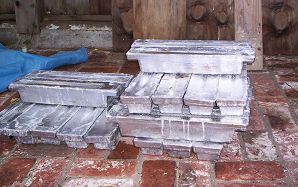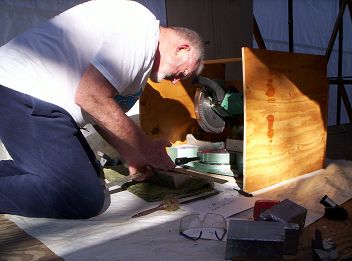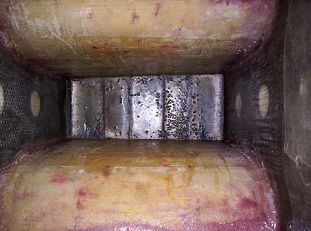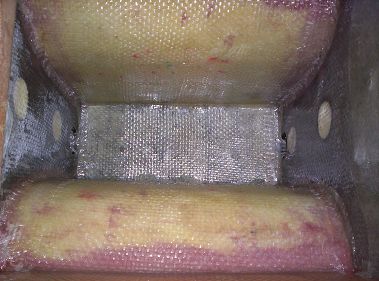Lead Keel - Continued
by Mike Worrell

Photo 1. Lead pigs. The issue of how to most efficiently stack these rectangular bricks into an elliptical keel was the next hurdle. That is, when one views the keel from above (plan view) it appears to be an ellipse or 'double airfoil'. When viewed from straight on, the keel has a 'V' shape - narrower on the bottom than at the top. Therefore each brick would have to be cut with a compound miter so that when stacked into the keel, there would be minimal voids or gaps. The solution to shaping each brick was a compound miter saw with a non-ferrous blade.

Photo 2. (You can see in the foreground of this photo the off-cut ends of a brick; those that were too small or irregular to re-use were saved and taken back to the foundry to be recast (again) into 'new' 50 lb bricks). Photo 2 Cutting lead bricks with compound miter saw & non-ferrous blade.
 Photo 3. As each piece was cut,
it was first weighed (on a bathroom scale) then stacked into the keel: There
were inevitable small voids around some of the bricks. These I filled with
small lead shot, swept into the voids with a whisk broom. Then each layer of
bricks was coated with a milled fiber and epoxy slurry.
Photo 3. As each piece was cut,
it was first weighed (on a bathroom scale) then stacked into the keel: There
were inevitable small voids around some of the bricks. These I filled with
small lead shot, swept into the voids with a whisk broom. Then each layer of
bricks was coated with a milled fiber and epoxy slurry.
Photo 4. Once all the bricks were stacked, the cavity got a covering of two 18 oz woven roving layers wet out with epoxy: In this way I was able to efficiently accomplish a 'tight' internal lead keel without having to light a fire!
Regards to All.
Mike Worrell
Los Angeles, CA